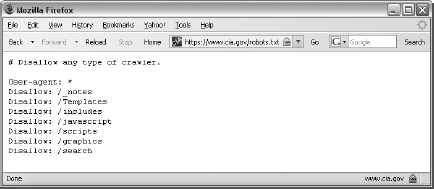Thus far, we have talked about how to create effective, stealthy, and smart webbots. However, there is also a market for developers who create countermeasures that defend websites from webbots and spiders. These opportunities exist because sometimes website owners want to shield their sites from webbots and spiders for these purposes:
Protect intellectual property
Shield email addresses from spammers
Regulate how often the website is used
Create a level playing field for all users
The first three items in this list are fairly obvious, but the fourth is more complicated. Believe it or not, creating a level playing field is one of the main reasons web developers cite for attempting to ban webbots from their sites. Online companies often try to be as impartial as possible when wholesaling items to resellers or awarding contracts to vendors. At other times, websites deny access to all webbots to create an assumption of fairness or parity, as is the case with MySpace. This is where the conflict exists. Businesses that seek to use the Internet to gain competitive advantages are not interested in parity. They want a strategic advantage.
Successfully defending websites from webbots is more complex than simply blocking all webbot activity. Many webbots, like those used by search engines, are beneficial, and in most cases they should be able to roam sites at will. It's also worth pointing out that, while it's more expensive, people with browsers can gather corporate intelligence and make online purchases just as effectively as webbots can. Rather than barring webbots in general, it's usually preferable to just ban certain behavior.
Let's look at some of the things people do to attempt to block webbots and spiders. We'll start with the simplest (and least effective) methods and graduate to more sophisticated practices.
Your first approach to defending a website from webbots is to request nicely that webbots and spiders do not use your resources. This is your first line of defense, but if used alone, it is not very effective. This method doesn't actually keep webbots from accessing data—it merely states your desire for such—and it may or may not express the actual rights of the website owner. Though this strategy is limited in its effectiveness, you should always ask first, using one of the methods described below.
The simplest way to ask webbots to avoid your website is to create a site policy or Terms of Service agreement, which is a list of limitations on how the website should be used by all parties. A website's Terms of Service agreement typically includes a description of what the website does with data it collects, a declaration of limits of liability, copyright notifications, and so forth. If you don't want webbots and spiders harvesting information or services from your website, your Terms of Service agreement should prohibit the use of automated web agents, spiders, crawlers, and screen scapers. It is a good idea to provide a link to the usage policy on every page of your website. Though some webbots will honor your request, others surely won't, so you should never rely solely on a usage policy to protect a website from automated agents.
Although an official usage policy probably won't keep webbots and spiders away, it is your opportunity to state your case. With a site policy that specifically forbids the use of webbots, it's easier to make a case if you later decide to play hardball and file legal action against a webbot or spider owner.
You should also recognize that a written usage policy is for humans to read, and it will not be understood by automated agents. There are, however, other methods that convey your desires in ways that are easy for webbots to detect.
The robots.txt file,[73] or robot exclusion file, was developed in 1994 after a group of webmasters discovered that search engine spiders indexed sensitive parts of their websites. In response, they developed the robots.txt file, which instructs web agents to access only certain parts of a site. According to the robots.txt specification, a webbots should first look for the presence of a file called robots.txt in the website's root directory before it downloads anything else from the website. This file defines how the webbot should access files in other directories.[74]
The robots.txt file borrows its Unix-type format from permissions files. A typical robots.txt file is shown in Figure 27-1.
In addition to what you see in Figure 27-1, a robots.txt file may disallow different directories for specific web agents. Some robots.txt files even specify the amount of time that webbots must wait between fetches, though these parameters are not part of the actual specification. Make sure to read the specification[75] before implementing a robots.txt file.
There are many problems with robots.txt. The first problem is that no recognized body, such as the World Wide Web Consortium (W3C) or a corporation, governs the specification. The robots exclusion file is actually the result of a "consensus of opinion" of members of a now-defunct robots mailing list. The lack of a recognized organizing body has left the specification woefully out of date. For example, the specification did not anticipate agent name spoofing, so unless a robots.txt file disallows all webbots, any webbot can comply with the imposed restrictions by changing its name. In fact, a robots.txt file may actually direct a webbot to sensitive areas of a website or otherwise hidden directories. A much better tactic is to secure your confidential information through authentication or even obfuscation. Perhaps the most serious problem with the robots.txt specification is that there is no enforcement mechanism. Compliance is strictly voluntary.
However futile the attempt, you should still use the robots.txt file if for no other reason than to mark your turf. If you are serious about securing your site from webbots and spiders, however, you should use the the tactics described later in this chapter.
Like the robots.txt file, the intent of the robots meta tag[76] is to warn spiders to stay clear of your website. Unfortunately, this tactic suffers from many of the same limitations as the robots.tx file, because it also lacks an enforcement mechanism. A typical robots meta tag is shown in Listing 27-1.
<head>
<meta name="robots" content="noindex, nofollow">
</head>
Listing 27-1: The robots meta tag
There are two main commands for this meta tag: noindex and nofollow. The first command tells spiders not to index the web page in search results. The second command tells spiders not to follow links from this web page to other pages. Conversely, index and follow commands are also available, and they achieve the opposite effect. These commands may be used together or independently.
The problem with site usage policies, robots.txt files, and meta tags is that the webbots visiting your site must voluntarily honor your requests. On a good day, this might happen. On its own, a Terms of Service policy, a robots.txt file, or a robots meta tag is something short of a social contract, because a contract requires at least two willing parties. There is no enforcing agency to contact when someone doesn't honor your requests. If you want to deter webbots and spiders, you should start by asking nicely and then move on to the tougher approaches described next.
[73] The filename robots.txt is case sensitive. It must always be lowercase.
[74] Each website should have only one robots.txt file.
[75] The robots.txt specification is available at http://www.robotstxt.org,
[76] The specification for the robots meta tag is available at http://www.robotstxt.org/wc/meta_user.html

